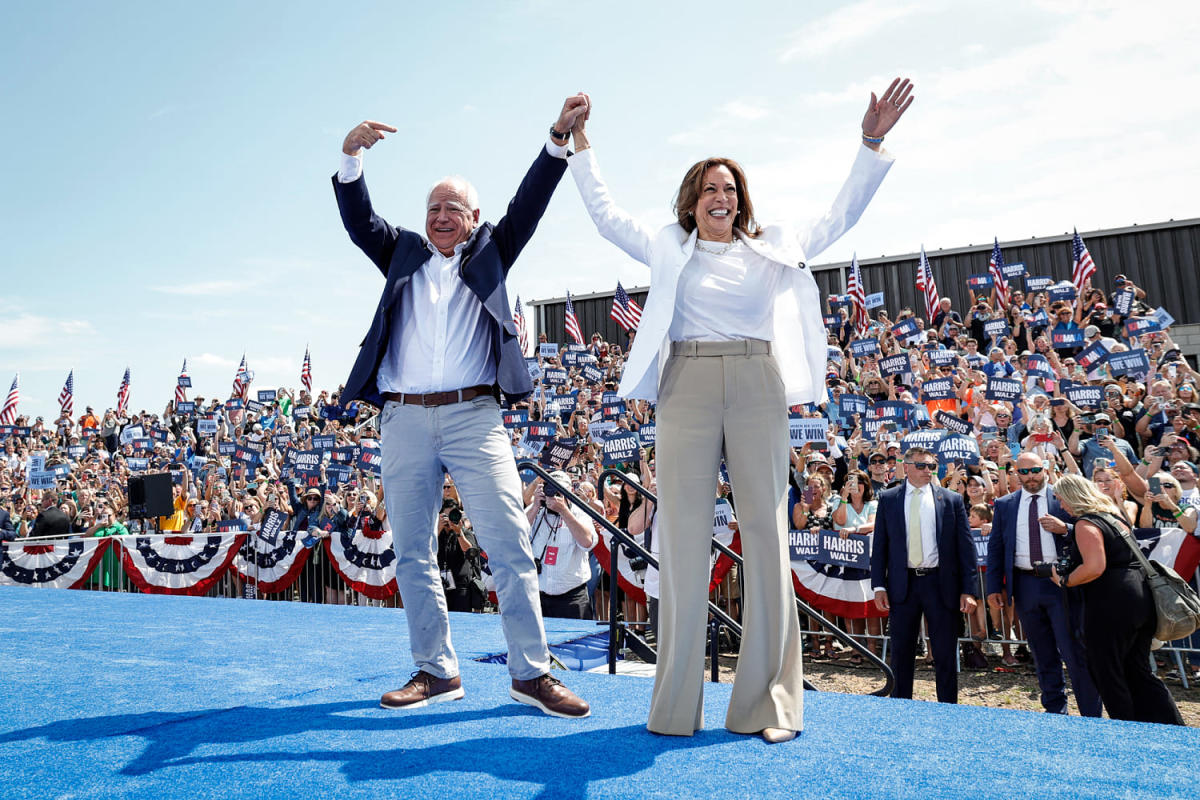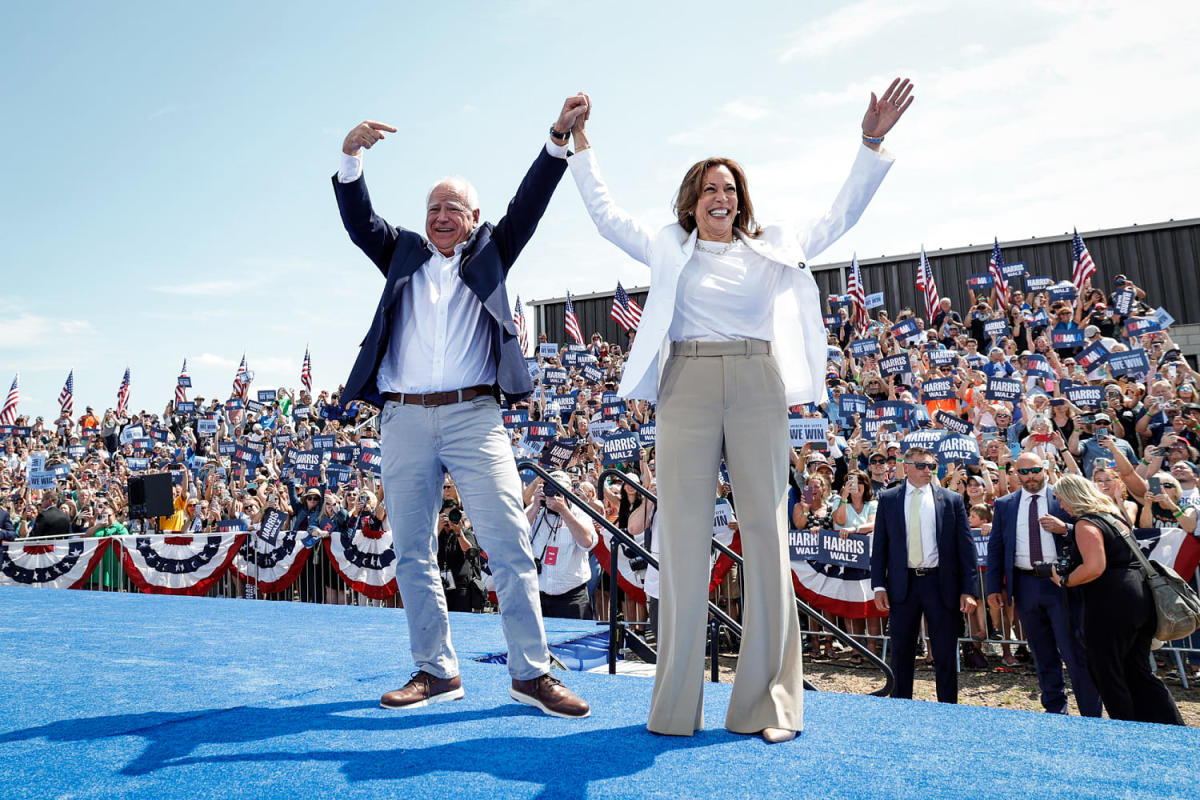
Expect to see more of Tim Walz this fall — in orange. Walz, the Democratic vice presidential candidate, will be donning a bright vest while pheasant hunting. That’s when he isn’t wearing tacky flannels, talking about cleaning his gutters or singing, “Save big money at Menards.”
The EveryDad image, rounded out by his nickname, “Coach Walz,” is an unmistakable signal aimed at reaching white working-class and rural voters, the kind of electorate the ticket of Vice President Kamala Harris and Walz is trying to attract in anticipation of fights to the finish in battleground states where narrowing loss margins in red counties could put them over the top.
Democrats say that for years, they all but ceded rural counties and even some exurbs to former President Donald Trump. Rural counties in states like Wisconsin and Nevada transformed into deep-red Trump territory and have been just about impenetrable to the left since 2016.
Harris campaign officials believe they have an opportunity with white moderate and blue-collar voters — among whom Harris may have softer appeal — by emphasizing Walz’s Midwest roots, military background, ties to labor, experience as a hunter and career as a football coach.
Harris, too, has signaled to those voters, leaning on her work as a prosecutor and her self-made biography as the immigrant daughter who worked at McDonald’s, then rose through the ranks to become vice president.
Overall, it’s a playbook not unlike Barack Obama’s in 2008, when he chose Joe Biden as his running mate. Then still early in his political career, Obama tapped a Washington veteran with expertise in foreign policy to appeal to labor and white working-class voters.
Some major players from Obama’s team are helping drive Harris’ campaign, including David Plouffe, who is a senior adviser on strategy; Stephanie Cutter, a senior adviser on messaging; and Jen O’Malley Dillon, the campaign chair.
The strategy was also used in 2020, but with Biden and Harris reversing roles. As a vice presidential contender, Harris was meant to help tap interest among women and voters of color as Biden touted his ties to labor and roots in Scranton, Pennsylvania.
John Anzalone, chief pollster in both Obama campaigns, as well as Biden’s 2020 run, is advising the Harris-Walz campaign. He said any presidential political strategist should remember that just a 44,000-vote advantage in battleground states put Biden over the top in 2020. Anzalone added that aggressive third-party spending in rural areas may just have made the difference.
“You can’t just do base politics. You need to do base expansion and narrow margins in demographics that are rougher for you,” he said. “You may get your ass kicked, but it’s about getting your ass kicked by a smaller margin.”
Jim Messina, who served as the campaign manager for Obama’s 2012 run, said Harris has had “the best month in American political history since Barack Obama won the South Carolina primary and went on a roll.”
“But in that 2008 Democratic primary campaign, he then lost Pennsylvania and Ohio and everything got harder,” Messina said, adding, “Vice President Harris has clawed to a tie. Maybe she’s up by a point, but this thing is still incredibly close.”
On the ground, the Biden campaign months ago began the work in those areas, putting down roots in rural counties of battleground states to reach out to potential voters they say Democrats have all but ignored for years.
“Democrats for many cycles failed to understand the value of sort of showing up in places that might be a little more difficult to win because they were less efficient,” said Dan Kanninen, battleground director for the Harris-Walz campaign. “It was more efficient to go to the big-city markets, maybe to focus on the suburbs, but less efficient to go to rural America, because the votes weren’t all in one place.”
Kanninen said that as the trend continued cycle after cycle, “you kind of just lose folks altogether.” Democrats were taking staggering losses of 80% to 20% in red counties, he said.
The campaign began to counter that early on by setting up offices and staffs in those communities, talking to voters and holding events, including surrogate bus tours through more rural areas, Kanninen said. Voters started showing up, he added, saying people “perhaps needed the invitation, needed a place to go.”
Now, the campaign is highlighting the Harris-Walz ticket in those areas. Some of the themes emphasized at the Democratic National Convention also went toward that goal, bringing Walz’s football team onto the convention stage, driving patriotic chants of “USA!” and featuring Democratic elected officials who were military veterans.
“It is something that you can do to attract a new kind of voter that hasn’t been part of the Democratic Party,” said a source close to the campaign. “You’ll see things like: Who is going to be a better shot shooting pheasant — Walz or [JD] Vance? We’re going to keep them off balance.”
The campaign sees an opening to reclaim images that have become associated with Republicans, including hunting, football and old-fashioned patriotism.
Walz is also expected to frequently trot out a biographical line that won much applause at the convention, when he spoke of being in his 40s with young kids and no political experience running for office in a deep-red district.
“But you know what? Never underestimate a public school teacher,” he said to roars from the crowd.
One of the pair’s first rallies was in Wisconsin’s rural Eau Claire, where 12,000 people showed up. Walz may have another advantage in rural Wisconsin. More than 600,000 predominantly rural Wisconsinites, according to the campaign, live in Minnesota media markets or in counties right across the river from Minnesota. That means those areas are far more familiar with Walz.
In Nevada, since Biden endorsed Harris on July 21, more than 3,000 new volunteers have signed up from rural areas alone.
The campaign, officials say, also plans to lean into issues tied to the administration, including stressing that recent infrastructure funding aims to bring high-speed internet to rural areas and touting Medicaid expansion, which has been popular in places like rural North Carolina. The state, which a Democratic presidential candidate has not won since 2008, has already opened offices in rural communities in six counties.
In Wisconsin, the Harris campaign has presences in red counties where Democrats have not opened offices before.
“Rural” means different things in different states. In North Carolina and Georgia, rural counties are more diverse, whereas the rural counties of Wisconsin and Nevada, for instance, are predominantly white. Harris’ campaign is highlighting the administration’s contributions in Georgia, including new clean energy jobs, rural health care and substantial investment in Georgia farmers.
Last week, speaking to reporters in Chicago, Senate Majority Leader Chuck Schumer, D-N.Y., said rural counties could also help decide the Senate and, by extension, the next president’s legislative agenda.
“We’re not going to win the rural counties, but we will decrease the margin by which Republicans win them,” Schumer said.
Republicans, in the meantime, painted Democrats as disconnected from voters who are concerned about border security, gas prices, a spike in car insurance rates in places like Nevada and the cost of groceries.
“These are kitchen-table issues, and those kitchen-table issues come home to roost. And Kamala Harris, for the last three years, has not done anything for us,” said Nevada GOP party chair Michael McDonald, a Trump adviser.
At the same time, McDonald gave a nod to the intensity of the contest in a state where early polling had Trump holding sizable leads over Biden. Harris’ entry as presidential candidate has improved Democratic numbers.
“They are running a serious campaign — as are we,” he said.
Trump’s team says it is more confident than ever in its depth of support in rural America. It is casting Harris as “dangerously liberal,” and it has painted Walz as a failed governor in addition to accusing him of inflating his military background.
“Team Trump has hundreds of paid staff, more than 300 offices, and tens of thousands of active volunteers across the battleground states and we are actively working to turn out voters in rural, suburban and urban communities where President Trump is making historic gains and the Democrats are being forced to play defense,” Trump spokesperson Karoline Leavitt said in a statement.
“If dangerously liberal Kamala Harris and Tim Walz think they’re going to pick up points in rural America, where hardworking families are being left behind by Kamala’s terrible policies as Vice President, they should think again,” she added. “Rural America is Trump Country more than ever.”
This article was originally published on NBCNews.com
EMEA Tribune is not involved in this news article, it is taken from our partners and or from the News Agencies. Copyright and Credit go to the News Agencies, email news@emeatribune.com Follow our WhatsApp verified Channel





